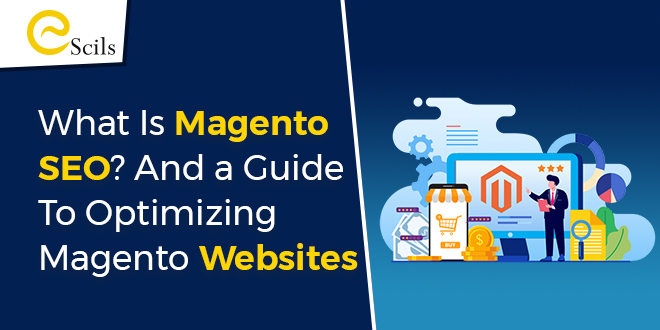If you are someone from the content marketing industry, you are probably already familiar with the word Magento SEO. It is one of the most famous and reliable Content Management systems out there. The expert designer teams of Coalition’s Technologies” have named it among the 3rd best CMS platforms in the market.
A Little Peek In
For those unfamiliar and have only just heard of the term, Magento SEO encompasses a set of SEO adjustments unique to the platform. This includes incredible SEO friendly features like sitemap.xml, robots.txt file and numerous ways to redirect pages. Magento SEO also offers opportunities to enhance website conversions by providing a faster website speed. And it goes without saying how much a site’s speed can affect the conversion rate on Magento. After all, in the fast-paced internet era, no one is patient enough to wait for buffering content to appear, especially when the “close” option is so nearby.
Where high speed is one of its appeals, Magento is known for its SEO capacities. A typical Magento website comes with all the necessary features and programming needed to attract loads of traffic. This delivers your e-commerce store efficiently to the web and makes your name known to all. It really is a treat, isn’t it?
So if you didn’t already know Magento has some vast benefits stored for you and for those already working with it, won’t it be lovely to optimize your Magento site and spark more profits? Well, here is a guide to doing just that!
Optimizing Magento Websites!
Before we dive into the optimization discussion, let us first understand the basics of optimizing any site to SEO standards. This basically means to fashion your site in a way such that search engines find your content easier for a specific search and display and rank yours higher than others on the search result page. A set of algorithms are hence followed to serve this purpose.
To evaluate your site to see where you are currently standing in the SEO world, you can take a look at the following factors and check whether you possess them or not.
- Technology: The technological foundation of your website will eventually determine how well search engines find and understand your site.
- Relevance: Is your content relevant to the demographic you traffic? If it is not, then search engines will have a hard time displaying your site to visitors.
- Authority and Trust: Showcase your authority and credibility by adding a helpful link to your site.
With foundations in mind, I am sure the fog in your mind regarding Magento optimization has already begun to clear. You are probably thinking of tricks and tactics of your own, and while you ponder upon those, here are a few suggestions to consider as well.
An SEO-promoting URL structure
The best way at achieving success in appearing on the top search page is by redefining your URL structure. If your site’s URL doesn’t coordinate well with visitors and search engines alike, then the chances of success will be pretty slim.
Hence make sure they are
- Easy to read
- Brief
- Consistent
- Lowercased
There are ample guides on the web to walk you through the process of changing URLs. Make sure to keep the points mentioned above in mind whilst doing that.
Crawling & indexing: Duplicate content & faceted navigation
Faceted navigation is one of the chief issues Magento sites face. They create massive crawling and indexing issues since their very presence increases the number of crawled pages. As faceted navigation will only result in existing products being sorted or narrowed down, this leads to similar and duplicate content.
To get rid of this issue
1. remove low quality indexed pages from faceted navigation
2. Review the log file of your site and find and eliminate the low quality crawled pages
3. Block crawl through robots.txt
4. Allow only high search potential pages to be crawled.
Indexable internal search pages
Get rid of Google crawling and indexing through low-quality search pages by applying the “no index” tag to them. After implementing the “no index” tag, make sure none of your internal search URLs gets indexed. You can do this by performing a search for “site:example.com inurl:/catalogsearch/”. If the URLs still appear in the index, wait till Google officially removes them.
Global Redirects
Magento allows global redirects to sites which means that if a store makes use of a ‘www’ domain or even ‘HTTP’ and a user doesn’t enter those, they will still be redirected to the correct destination. This comes as a great experience on the user’s side, and it gives them space for errors while still being led correctly to their desired destination. The problem is Magento operates this through 302 redirects instead of 301. Changing this for better functionality is recommended, of course, and the change is pretty easy too. Why not improve the advantages then?
Here is how to do it
1. Go to Stores > Configuration
2. At the “General” dropdown, click “Web.”
3. Select the “URL Options.”
4. Change “Auto-redirect to Base URL” to “Yes (301 Moved Permanently).”
More Like This: Related products
A related product is another one of Magento’s great features. It increases user engagement by suggesting more of the products they are interested in and increasing your revenue by introducing users to upsell opportunities. Still, it mostly skyrockets your overall SEO performance. To set this up go to Magento’s product pages and set “Related Products” for a specific product by searching the product and finding “Related Products, Up-Sells, and Cross-Sells”. Click on “Add Related Products” and add any other products you are offering that might also intrigue your users. And that’s all. You are now on your way to increasing your name and revenue.
Blogging functionality
Magento has a list of great features, but one particular weakness that stood out has been the lack of blogging functionality offered. With time we have seen ecommerce stores thrive through their blogs. The consistently promoting and engaging content has been at the forefront of driving traffic. Blogs have become the natural place for the content information to live. Without such informational content, magneto pages will have a hard time being ranked with only targeted keywords and all. For the moment, you can utilize your Magento store and make a blog out of it. (blog.example.com). Setting one of these up is highly recommended to provide your site with a platform for informational content and space to drive audience excitement.
EndNote
Running an e-commerce store is hard enough, let alone with SEO friendly features. New things are entering the field every day and the battle to appear higher in ranks keeps getting challenging. But with problems, solutions are invented or instead identified too. So keep your head up and keep fighting. Given the above strategies of Magento sites, you are already halfway near the finish line anyways. Here is a shout out to you for doing your research and not giving up! You got this!


